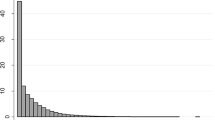Abstract
It is possible to partially order cities according to the informativeness of neighborhoods about their ethnic groups. It is also possible to partially order cities with two ethnic groups according to the Lorenz criterion. We show that a segregation order satisfies four well-established segregation principles if and only if it is consistent with the informativeness criterion. We then use this result to show that for the two-group case, the Lorenz and the informativeness criteria are equivalent.



Similar content being viewed by others
Notes
Recall that a Markov matrix is a non-negative matrix with each row summing to one. Recall also that a permutation matrix is one that is obtained by permuting the columns of an identity matrix.
Given \(\succcurlyeq \), the associated relations \(\succ \) and \(\sim \) are defined as usual: \(X\succ Y\Leftrightarrow X\succcurlyeq Y\) and not \( Y\succcurlyeq X\), and \(X\sim Y\Leftrightarrow X\succcurlyeq Y\) and \( Y\succcurlyeq X\).
Massey and Denton (1988) define evenness as the “differential distribution of two social groups among areal units in a city” and James and Taeuber (1985) see segregation as the “differential distribution of students to schools by race regardless of the overall racial proportions in the system concerned.
The generalized inverse of a distribution function \(F: {\mathbb {R}} _{+}\rightarrow [0,1]\) is defined as \(F^{-1}:[0,1]\rightarrow {\mathbb {R}} _{+}\) such that \(F^{-1}(p)=\inf _{s}\left\{ s>0:F(s)>p\right\} \).
Otherwise, the whole analysis can be done using \(A\cdot P\) instead of \(A\), \(S_{k}\cdot P\) instead of \(S_{k},\,P^{T}\cdot \Pi \) instead of \(\Pi \) and \(P^{T}\cdot \Pi ^{\prime }\cdot P\) instead of \(\Pi ^{\prime }\).
References
Andreoli F, Zoli C (2013) On the measurement of dissimilarity and related orders. Mimeo, New York
Ballester C, Vorsatz M (2013) Random-walk-based segregation measures. Rev Econ Stat. doi:101162/REST\_a\_003399
Blackwell D (1951) Comparison of experiments, proceedings of the second berkeley symposium on mathematical statistics and probability. University of California Press, Berkeley, pp 93–102
Blackwell D (1953) Equivalent comparisons of experiments. Ann Math Stat 24:265–272
Duncan O, Duncan B (1955) A methodological analysis of segregation indexes. Am Sociol Rev 20(2):210–217
Echenique F, Fryer RG Jr (2007) A measure of segregation based on social interactions. Q J Econ 122:441–485
Frankel D, Volij O (2011) Measuring school segregation. J Econ Theory 146:1–38
Grant S, Kajii A, Polak B (1998) Intrinsic preference for information. J Econ Theory 83:233–259
Hutchens R (1991) Segregation curves, Lorenz curves, and inequality in the distribution of people across occupations. Math Soc Sci 21:31–51
James DR, Taeuber KE (1985) Measures of segregation. Sociol Methodol 15:1–32
Jahn J, Schmidt CF, Schrag C (1947) The measurement of ecological segregation. Am Sociol Rev 12:293–303
Lasso de la Vega C, Volij (2013) Segregation, informativeness and Lorenz dominance. Monaster Center Discussion Paper 13–12
Massey DS, Denton NA (1988) The dimensions of racial segregation. Soc Forces 67:281–315
Reardon SF, Firebaugh G (2002) Measures of multigroup segregation. Sociol Methodol 32:33–67
Shaked M, Shanthikumar JG (2007) Stochastic orders, springer series in statistics. Springer, New York
Sherman S (1951) On a theorem of hardy, littlewood, polya, and Blackwell. PNAS 37:826–831
Taeuber KE, James DR (1982) Racial segregation among public and private schools. Sociol Educ 55:133–143
Acknowledgments
We thank Mikel Bilbao, Sergiu Hart and Robert Hutchens for their valuable comments. Sergiu Hart helped us shorten the proof of Theorem 2 by pointing to Sherman’s (1951) version of the Blackwell–Sherman–Stein theorem. We also thank the Spanish Ministerio de Economía y Competitividad (Project ECO2012-31346) and the Gobierno Vasco (Project IT568-13) for research support.
Author information
Authors and Affiliations
Corresponding author
Appendix
Appendix
Proof of Lemma 1
Let \(A\) be an \(n\times m\) Markov matrix and let \(B\) be an \(n\times (m+1)\) Markov matrix that is obtained from \(A\) by splitting one of \(A\)’s columns into two. Assume that \(A\)’s \(k\)th column is the one that is split. Alternatively, \(A\) is obtained from \(B\) by replacing \(B\)’s \(k\)th and \((k+1)\)th columns by their sum. Consequently,
where
Let us now assume that there is an \(m\times (m+1)\) Markov matrix \(\Pi \) such that
We will show that \(B\) is necessarily obtained from \(A\) by splitting \(A\)’s \(k\) th column proportionally.
Let \(\Pi ^{\prime }\) be the matrix that is obtained from \(\Pi \) by replacing \(\Pi \)’s \(k\)th and \((k+1)\)th columns by their sum. That is,
Note that \(\Pi ^{\prime }\) is a square \(m\times m\) Markov matrix. Moreover, by (10), (9) and (8),
which means that each row of \(A\) is an invariant distribution of the matrix \( \Pi ^{\prime }\).
Since \(\Pi ^{\prime }\) is a square Markov matrix, there exists \(r\ge 1\) and a permutation matrix \(P\) such that \(P^{T}\cdot \Pi ^{\prime }\cdot P\) can be written in the following (almost block diagonal) form:
where for all \(j=1,\ldots ,r,\,R_{j}^{\prime }\) are square \(\left( m_{j}\times m_{j}\right) \) irreducible Markov matrices and \(Q^{\prime }\) is an \(\left( n-\sum _{j=1}^{r}m_{j}\right) \times \left( n-\sum _{j=1}^{r}m_{j}\right) \) reducible matrix. We can assume without loss of generality that \(P\) is the identity matrix and thus that \(\Pi ^{\prime }\) has the above form.Footnote 8
Since \(R_{j}^{\prime }\), for \(j=1,\ldots ,r\), is an irreducible Markov matrix, it has unique invariant distribution \(q ^{j}=(q _{1}^{j},\ldots ,q _{m_{j}}^{j})\), i.e., \(q ^{j}\) is the unique probability vector \(q \) that satisfies \(q =q R_{j}^{\prime }\). Furthermore, any invariant distribution of \(\Pi ^{\prime }\) can be written as
for some \(\alpha _{1},\ldots \alpha _{r}\ge 0\) and \(\sum _{j=1}^{r}\alpha _{j}=1\) (see, for instance, Lucas and Stokey 1989 (Theorem 11.1, pages 326–330)). Therefore, since each row of \(A\) is an invariant distribution of \( \Pi ^{\prime }\), it can be written as
where for each \(i=1,\ldots ,n\) and \(j=1,\ldots ,r,\,\alpha _{ij}\ge 0\) and \(\sum _{j=1}^{r}\alpha _{ij}=1\). If \(B\) was obtained from \(A\) by splitting column \(k\) in a disproportional way, it ought to be the case that this column is one that has at least one positive entry.
Assume that column \(k\) corresponds to the \(h\)th block of \(\Pi ^{\prime }\). Therefore we can write
where \(v_{*k}^{\prime }=(v_{1k}^{\prime },\ldots ,v_{m_{h}k}^{\prime })^{T}\) is the column of block \(R_{h}^{\prime }\) that corresponds to the \(k\)th column of \(\Pi ^{\prime }\). Since \(\Pi \) is obtained from \(\Pi ^{\prime }\) by splitting the \(k\)th column into two, \(\Pi \) can be written as
where \(v_{*k}\) and \(v_{*k+1}\) are column vectors such that \(v_{*k}+v_{*k+1}=v_{*k}^{\prime }\). Consequently, since \(B=A\cdot \Pi \), using (12) and (13) we obtain that \(B\)’s \(k\)th column is \(\left( \alpha _{1h}q ^{h}v_{*k},\ldots ,\alpha _{nh}q ^{h}v_{*k}\right) ^{T} \) and, \(B\)’s \((k+1)\)th column is \(\left( \alpha _{1h}q ^{h}v_{*k+1},\ldots ,\alpha _{nh}q ^{h}\right. \) \(\left. v_{*k+1}\right) ^{T}\), which are proportional to each other (the proportion is \(q ^{h}v_{*k}/q ^{h}v_{*k+1}\)). \(\square \)
Rights and permissions
About this article
Cite this article
de la Vega, C.L., Volij, O. Segregation, informativeness and Lorenz dominance. Soc Choice Welf 43, 547–564 (2014). https://doi.org/10.1007/s00355-014-0801-3
Received:
Accepted:
Published:
Issue Date:
DOI: https://doi.org/10.1007/s00355-014-0801-3




